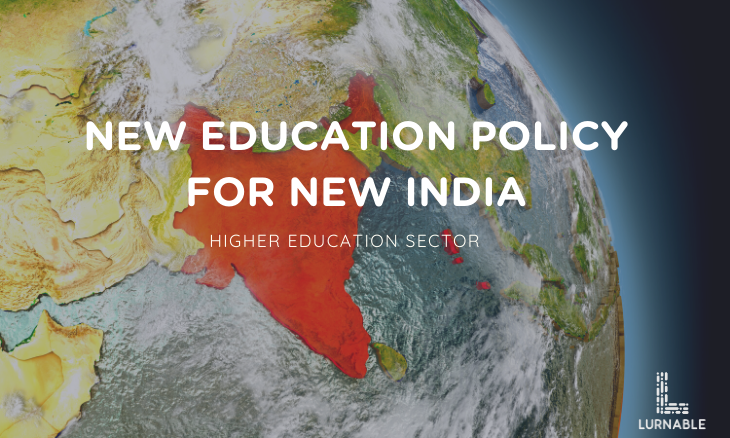Indian Prime Minister Narendra Modi has approved a new education policy to meet the needs and goals of 21st-century education and skills development.
The new policy has been built on the foundational pillars of Access, Equity, Quality, Affordability and Accountability. It is aligned to the 2030 Agenda for Sustainable Development and aims to transform India into a vibrant knowledge society and global knowledge superpower by making both school and college education more holistic, flexible, multidisciplinary, suited to 21st century needs and aimed at bringing out the unique capabilities of each student.
This announcement marks an important milestone in the Indian history of education reforms as it replaces the 34-year-old National Policy on Education (NPE), 1986. It has brought in the much-needed education reforms both in the higher education and schools’ education sector.
“The education sector to get 6% of India’s over all GDP as opposed to the 1.7% in the past”
National Education Policy 2020 Major Reforms – Higher Education Sector
- Higher Education Commission of India (HECI):
The new education policy 2020 has announced the set up of a common regulatory body the country’s entire higher education sector. The new regulatory body, Higher Education Commission of India (HECI) replacing the UGC-AICTE regime, will be set up as a single overarching umbrella body the for entire higher education, excluding medical and legal education.
HECI to have four independent verticals:
1. National Higher Education Regulatory Council (NHERC) for regulation
2. General Education Council (GEC) for standard-setting
3. Higher Education Grants Council (HEGC) for funding
4. National Accreditation Council (NAC) for accreditation
HECI will function through faceless intervention through technology, & will have powers to penalise HEIs not conforming to norms and standards. Public and private higher education institutions will be governed by the same set of norms for regulation, accreditation and academic standards.
- Gross Enrolment Ratio:
NEP 2020 is focusing on activities to increase the Gross Enrolment Ration in higher education including vocational education from 26.3% (2018) to 50% by 2035 by increasing 35000000 new seats in Higher Education institutions.
- National Scholarship Portal:
Efforts will be made to incentivize the merit of students belonging to SC, ST, OBC, and other SEDGs. The National Scholarship Portal will be expanded to support, foster, and track the progress of students receiving scholarships. Private HEIs will be encouraged to offer larger numbers of free ships and scholarships to their students.
- Digital & Online Learning:
A dedicated unit for the purpose of orchestrating the building of digital infrastructure, digital content and capacity building will be created in the MHRD to look after the e-education needs of both school and higher education.
The new education policy 2020 emphasized on effective models of blended learning and to enhance educational access to disadvantage groups including Divyang students.
- Distance & Open Learning:
Measures such as online courses and digital repositories, funding for research, improved student services, credit-based recognition of MOOCs, etc., will be taken to ensure it is at par with the highest quality in-class programmes.
- Financial Autonomy:
There are over 45,000 affiliated colleges in our country. Under Graded Autonomy, Academic, Administrative and Financial Autonomy will be given to colleges, on the basis of the status of their accreditation.
- Adult Education:
The NEP 2020 proposes innovative initiatives for adult’s education through community participation, technology integration and integration of Adult Education Centres (AECs) with Higher Education Institutions and other public institutions.
Technology based high quality options for adult learning such as apps, online courses and modules, satellite-based TV channels and online books, ICT equipped libraries are to be developed through government and philanthropic initiatives.
The policy has outlined that the Adult Education Curriculum will include Following Five Types Of Programme:
A. Foundational Literacy and Numeracy
B. Critical Life Skills
C. Vocational Skills Development
D. Basic Education
E. Continuing Education
The new education policy aims to achieve 100% youth and adult literacy in India.
- E-Content in Indian Languages:
“E-courses will be developed in eight regional languages initially and virtual labs will be developed,” Amit Khare, Higher Education Secretary, said.
- Multiple Entry & Exit Programme:
The policy envisages broad based, multi-disciplinary, holistic Undergraduate education with flexible curricula, creative combinations of subjects, integration of vocational education and multiple entry and exit points with appropriate certification.
UG education can be of 3 or 4 years with multiple exit options and appropriate certification within this period.
For example, if you exit the degree programme after the first year you would still receive a Certificate, Advanced Diploma after 2 years, Bachelor’s Degree after 3 years and bachelor’s with Research after 4 years.
- National Research Foundation:
A new National Research Foundation to be established as an apex body for fostering a strong research culture and building research capacity across higher education in India.
The National Research Foundation will be governed, independently of the government, by a rotation Board of Governors consisting of the very best researchers and innovators across fields.
- Colleges Affiliation:
Affiliation of colleges is to be phased out in 15 years and a stage-wise mechanism is to be established for granting graded autonomy to colleges. Over a period of time, it is envisaged that every college would develop into either an Autonomous degree-granting College, or a constituent college of a university.
- National Committee for Integration of Vocational Education:
NEP 2020 announced that “Lok Vidya” – important vocational knowledge developed in India, will be made accessible to students. The education ministry, would constitute a National Committee for the Integration of Vocational Education (NCIVE).
- Academic Bank of Credit:
The policy announced the establishment of Academic Bank of Credit to digitally store academic credits earned from different Higher Education Institutions so that these can be transferred and counted towards final degree earned.
- Multidisciplinary Education & Research Universities:
NEP 2020 has announced the setup of Multidisciplinary Education & Research Universities (MERU) at par with IITs, IIMs as models of best multidisciplinary education of global standards in the country.
Standalone Higher Education Institutes and professional education institutes will be evolved into multi-disciplinary education.
- Indian Institute of Translation & Interpretation (IITI):
In order to ensure the preservation, growth, and vibrancy of all Indian languages, NEP 2020 recommends setting an Indian Institute of Translation and Interpretation (IITI), National Institute(s) for Pali, Persian and Prakrit, strengthening of Sanskrit and all language departments in Higher Education Institutions in India.
- Rationalised Institutional Architecture:
Higher education institutions will be transformed into large, well resourced, vibrant multidisciplinary institutions providing high quality teaching, research, and community engagement. The definition of university will allow a spectrum of institutions that range from Research-intensive Universities to Teaching-intensive Universities and Autonomous degree-granting Colleges.
- Mentoring Mission:
A National Mission for Mentoring will be established, with a large pool of outstanding senior/retired faculty – including those with the ability to teach in Indian languages – who would be willing to provide short and long-term mentoring/professional support to university/college teachers.
- Faculty Development:
NEP makes recommendations for motivating, energizing, and building capacity of faculty through clearly defined, independent, transparent recruitment, freedom to design curricula/pedagogy, incentivising excellence, movement into institutional leadership. Faculty not delivering on basic norms will be held accountable.
- Professional Education:
All professional education will be an integral part of the higher education system. Stand-alone technical universities, health science universities, legal and agricultural universities etc will aim to become multi-disciplinary institutions.
- Technology in Education:
National Educational Technology Forum (NETF), a new autonomous body, will be created to provide a platform for the free exchange of ideas on the use of technology to enhance learning, assessment, planning, administration.
Appropriate integration of technology into all levels of education will be done to improve classroom processes, support teacher professional development, enhance educational access for disadvantaged groups and streamline educational planning, administration and management.
- International Students Office:
An ‘International Students Office’ at each Higher Education Institution hosting foreign students will be set up to coordinate all matters relating to welcoming and supporting students arriving from abroad.
- International Exchange Programmes’ Credit Transfer:
The new education policy has stated that the credits acquired in foreign universities will be permitted, where appropriate as per the requirements of each (Higher Education Institution) HEI, to be counted for the award of a degree.
- International Academic Collaborations:
According to NEP 2020, research/teaching collaborations and faculty/student exchanges with high-quality foreign institutions will be facilitated, and relevant mutually-beneficial MOUs with foreign countries will be signed.
- World’s Top-Ranking Universities to Set up Campus in India:
Internationalisation of education will be facilitated through both institutional collaborations and student and faculty mobility and allowing entry of top world ranked Universities to open campuses in our country.
According to the HRD Ministry document, listing salient features of policy, “such (foreign) universities will be given special dispensation regarding regulatory, governance, and content norms on par with other autonomous institutions of India.”
- Best Indian Universities to Set up Campuses Abroad:
High performing Indian universities will be encouraged to set up campuses in other countries.
Speaking to media in New Delhi yesterday after the Cabinet approved the New Education Policy 2020, the Union Minister for Human Resource Development Shri Ramesh Pokhariyal said that the NEP was drawn up after the largest consultation and discussion process of its kind in the country. He also added that more than 2 lakh suggestions were received after the draft was placed in public domain for consultations. It is to be noted that the consultation process took place via multiple avenues including a dedicated web portal for the cause, several education dialogues with the members of parliament and leaders of local government across India.









